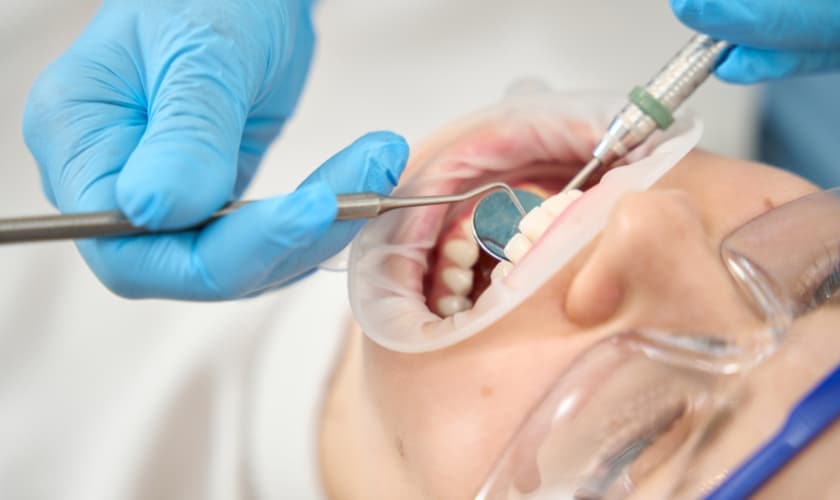Ever wonder what goes beyond a regular dental cleaning? If you’ve been diagnosed with gum disease, your dentist might recommend scaling and root planing, a procedure often referred to as a “deep cleaning.” But what exactly does it involve, and how is it different from a routine cleaning?
Understanding Gum Disease
Gum disease, also known as periodontal disease, is an infection of the gums that surrounds your teeth. It’s caused by a buildup of plaque and tartar, which are breeding grounds for harmful bacteria. If left untreated, gum disease can damage the soft tissue and bone that support your teeth, eventually leading to tooth loss.
The Two-Part Approach: Scaling and Root Planing
Scaling and root planning work together to combat gum disease. Here’s a breakdown of each step:
- Scaling: This is the first part of the procedure, where your dentist or hygienist removes plaque and tartar from above and below the gum line. Special tools, like ultrasonic scalers, are used to break up and dislodge the buildup. This process helps reduce inflammation and create a cleaner surface for the next step.
- Root Planing: After scaling, your dentist smoothens the rough surfaces of the tooth roots. This is crucial because plaque and tartar tend to stick more easily to rough surfaces. Smoothing the roots discourages future buildup and allows your gums to reattach more firmly to the teeth.
Think of it like this: Imagine your teeth are like a house, and your gums are the foundation. Plaque and tartar buildup are like unwanted guests creating a mess inside the foundation. Scaling removes the unwanted guests, while root planing repairs the foundation, making it harder for them to re-enter.
How is Scaling and Root Planing Different from Regular Cleaning?
A regular dental cleaning focuses on preventive care. It removes plaque and tartar from accessible surfaces above the gum line. Scaling and root planing, on the other hand, go much deeper, targeting areas below the gum line and addressing the root surfaces. It’s also a more involved procedure, often requiring local anesthesia due to potential discomfort.
Who Needs Scaling and Root Planing?
Scaling and root planing are typically recommended for people with moderate to advanced gum disease. Signs that you might need this procedure include:
- Bleeding gums
- Red, swollen, or tender gums
- Persistent bad breath
- Receding gums
- Loose teeth
What to Expect During the Procedure
Scaling and root planning may be completed in one or two appointments, depending on the severity of your gum disease. Here’s a general idea of what to expect:
- Consultation: Your dentist will discuss your gum health and determine if scaling and root planning are the right course of action. X-rays and various diagnostic tools can be utilized to evaluate the severity of gum disease.
- The Procedure: You will be comfortably seated in the dental chair. Local anesthesia might be used depending on your needs. Your dentist or hygienist will then perform scaling and root planing using specialized tools. Ultrasonic scalers and hand instruments are commonly used for scaling, while curettes are used for root planing.
- Aftercare: You might experience some soreness or sensitivity after the procedure, especially if you required local anesthesia. Over-the-counter pain medication can help manage discomfort. Your dentist will provide specific instructions on caring for your teeth and gums during recovery. This may include using a special mouthwash and avoiding certain foods.
Maintaining Healthy Gums After Scaling and Root Planing
Scaling and root planing are effective treatments for gum disease, but they’re not a one-time fix. To maintain healthy gums and prevent future problems, it’s crucial to:
- Practice good oral hygiene: Brushing your teeth twice a day for two minutes each time and flossing daily are the cornerstones of good oral hygiene. Using a soft-bristled toothbrush and proper brushing technique can help remove plaque and debris from the gum line without irritating the gums.
- Maintain regular dental checkups and cleanings: Regular professional cleanings, typically recommended every six months, help remove plaque and tartar before they become a problem. These cleanings may also include polishing the teeth to remove stains and make it more difficult for plaque to adhere.
- Consider quitting smoking: Smoking is a major risk factor for gum disease. It weakens the immune system’s ability to fight infection and can hinder healing after dental procedures. Quitting smoking can significantly improve your overall health, including your oral health.
If you’re experiencing symptoms of gum disease, don’t hesitate to schedule an appointment with your dentist in Watford. Early diagnosis and treatment can help prevent gum disease from progressing and protect your oral health. Keep in mind, healthy gums are crucial for maintaining a healthy smile!





